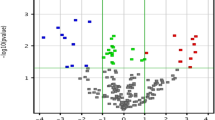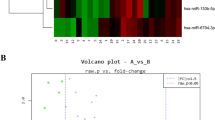Abstract
Background
Hyperlipidemia is a major risk factor for vascular endothelial injury and atherosclerosis leading to cardiovascular diseases. Early diagnosis of vascular endothelial injury is important for the prevention and prognosis of cardiovascular diseases. This study aimed to investigate sensitive circulating microRNA (miRNA) as a potential diagnostic biomarker of vascular endothelial injury in a hyperlipidemic rat model.
Methods
The miRNA expression profile was detected by miRNA microarray. The hyperlipidemic rat model was established by intraperitoneal injection of vitamin D3 combined with a high-fat diet. Plasma miRNA levels were measured by quantitative reverse transcriptase polymerase chain reaction (qRT-PCR).
Results
No significant difference was found in the types of highly expressed miRNAs between human umbilical artery endothelial cells (HUAEC) and human umbilical vein endothelial cells (HUVEC). A total of 10 highly expressed miRNAs in endothelial cells were selected as candidate miRNAs, including miR-21, miR-126, let-7a, miR-23a, miR-221, miR-125b, miR-26a, miR-29a, miR-16, and miR-100. The plasma levels of let-7a, miR-126, miR-21, and miR-26a were significantly elevated in hyperlipidemic rats at 30 and 50 days after modeling, while the plasma level of miR-29a was significantly decreased. No significant change was found in the plasma levels of miR-125b, miR-23a, miR-221, miR-100, and miR-16. Interestingly, a significant reduction in plasma miR-29 level was detected as early as 20 days after modeling, which was earlier than for soluble intercellular adhesion molecule‑1 (sICAM-1).
Conclusion
The plasma levels of endothelial cell-enriched miRNAs were correlated with vascular endothelial injury induced by hyperlipidemia. miR-29a might serve as a potential early diagnostic biomarker of endothelial injury-related diseases.
Zusammenfassung
Hintergrund
Hyperlipidämie ist ein wesentlicher Risikofaktor für vaskuläre endotheliale Läsionen und Arteriosklerose, die zu kardiovaskulären Erkrankungen führen können. Eine frühe Diagnosestellung hinsichtlich der vaskulären endothelialen Läsionen ist wichtig für die Prävention und Prognose von kardiovaskulären Erkrankungen. Ziel der vorliegenden Studie war es, entsprechend sensitive zirkulierende microRNA (miRNA) als potenziellen diagnostischen Biomarker für vaskuläre endotheliale Läsionen in einem Tiermodell mit hyperlipidämischen Ratten zu untersuchen.
Methoden
Das miRNA-Expressionsprofil wurde mittels miRNA-Microarray bestimmt. Das Tiermodell der hyperlipidämischen Ratten wurde durch eine intraperitoneale Injektion von Vitamin D3 in Kombination mit einer Ernährung mit hohem Fettanteil erzeugt. Plasma-miRNA-Werte wurden durch quantitative Polymerasekettenreaktion unter Nutzung der reversen Transkriptase (qRT-PCR) ermittelt.
Ergebnisse
Zwischen Endothelzellen aus der humanen Nabelschnurarterie (HUAEC) und Endothelzellen aus der humanen Nabelschnurvene (HUVEC) wurden keine wesentlichen Unterschiede in Bezug auf die Typen von miRNA mit hoher Expression festgestellt. Als Kandidaten-miRNA wurden 10 miRNA mit hoher Expression in Endothelzellen ausgewählt, darunter miR-21, miR-126, let-7a, miR-23a, miR-221, miR-125b, miR-26a, miR-29a, miR-16 und miR-100. Die Plasmaspiegel von let-7a, miR-126, miR-21 und miR-26a waren 30 bzw. 50 Tage nach Erzeugung des Tiermodells bei hyperlipidämischen Ratten deutlich erhöht, während der Plasmaspiegel von miR-29a deutlich erniedrigt war. Bei den Plasmaspiegeln von miR-125b, miR-23a, miR-221, miR-100 und miR-16 war keine wesentliche Veränderung festzustellen. Interessant ist, dass eine deutliche Reduktion des Plasmaspiegels von miR-29 bereits 20 Tage nach Erzeugung des Tiermodells beobachtet wurde, was ein früherer Zeitpunkt war als beim löslichen interzellulären Adhäsionsmolekül‑1 (sICAM-1) war.
Schlussfolgerung
Die Plasmaspiegel von in Endothelzellen angereicherten miRNA waren mit vaskulären endothelialen Schädigungen durch Hyperlipidämie korreliert. miR-29a könnte als potenzieller früher diagnostischer Biomarker für Erkrankungen dienen, die mit endothelialen Schädigungen einhergehen.




Similar content being viewed by others
References
Menghini R, Stohr R, Federici M (2014) MicroRNAs in vascular aging and atherosclerosis. Ageing Res Rev 17:68–78
Wu Y et al (2018) Murine models of vascular endothelial injury: techniques and pathophysiology. Thromb Res 169:64–72
Godo S, Shimokawa H (2017) Endothelial Functions. Arterioscler Thromb Vasc Biol 37(9):e108–e114
Steyers CM 3rd, Miller FJ Jr. (2014) Endothelial dysfunction in chronic inflammatory diseases. Int J Mol Sci 15(7):11324–11349
Jensen HA, Mehta JL (2016) Endothelial cell dysfunction as a novel therapeutic target in atherosclerosis. Expert Rev Cardiovasc Ther 14(9):1021–1033
Hijmans JG et al (2019) Circulating microparticles are elevated in treated HIV‑1 infection and are deleterious to endothelial cell function. J Am Heart Assoc 8(4):e11134
Leite AR et al (2020) Novel biomarkers for evaluation of endothelial dysfunction. Angiology 71(5):397–410
Wang GK et al (2010) Circulating microRNA: a novel potential biomarker for early diagnosis of acute myocardial infarction in humans. Eur Heart J 31(6):659–666
Goretti E, Wagner DR, Devaux Y (2014) miRNAs as biomarkers of myocardial infarction: a step forward towards personalized medicine? Trends Mol Med 20(12):716–725
Wronska A, Kurkowska-Jastrzebska I, Santulli G (2015) Application of microRNAs in diagnosis and treatment of cardiovascular disease. Acta Physiol 213(1):60–83
Wu Y et al (2009) Anti-atherogenic effects of centipede acidic protein in rats fed an atherogenic diet. J Ethnopharmacol 122(3):509–516
Almofti MR et al (2006) Proteomic analysis of rat aorta during atherosclerosis induced by high cholesterol diet and injection of vitamin D3. Clin Exp Pharmacol Physiol 33(4):305–309
Barquera S et al (2015) Global overview of the epidemiology of atherosclerotic cardiovascular disease. Arch Med Res 46(5):328–338
Herrington W et al (2016) Epidemiology of atherosclerosis and the potential to reduce the global burden of atherothrombotic disease. Circ Res 118(4):535–546
Chen Y et al (2010) High levels of soluble intercellular adhesion molecule‑1, insulin resistance and saturated fatty acids are associated with endothelial dysfunction in healthy adolescents. Atherosclerosis 211(2):638–642
Vargova K et al (2008) Circulating endothelial cell count, plasma vWF and soluble ICAM‑1 levels following primary or elective percutaneous coronary intervention. Atherosclerosis 198(2):366–372
Gendron N, Smadja DM (2016) Circulating endothelial cells: a new biomarker of endothelial dysfunction in hematological diseases. Ann Biol Clin 74(4):395–404
Wu H, Chen H, Hu PC (2007) Circulating endothelial cells and endothelial progenitors as surrogate biomarkers in vascular dysfunction. Clin Lab 53(5–6):285–295
Bartoloni E et al (2015) Characterization of circulating endothelial microparticles and endothelial progenitor cells in primary Sjogren’s syndrome: new markers of chronic endothelial damage? Rheumatology 54(3):536–544
Song R et al (2015) Association of endothelial microparticle with NO, eNOS, ET‑1, and fractional flow reserve in patients with coronary intermediate lesions. Biomarkers 20(6–7):429–435
Scrutinio D et al (2017) Circulating microRNA-150-5p as a novel biomarker for advanced heart failure: a genome-wide prospective study. J Heart Lung Transplant 36(6):616–624
Huang D et al (2020) MicroRNA-221 is a potential biomarker of myocardial hypertrophy and fibrosis in hypertrophic obstructive cardiomyopathy. Biosci Rep 40(1):BSR20191234
van Solingen C et al (2015) The role of microRNA-126 in vascular homeostasis. Curr Vasc Pharmacol 13(3):341–351
Tang F, Yang TL (2018) MicroRNA-126 alleviates endothelial cells injury in atherosclerosis by restoring autophagic flux via inhibiting of PI3K/Akt/mTOR pathway. Biochem Biophys Res Commun 495(1):1482–1489
Ding S et al (2020) Inhibiting microRNA-29a protects myocardial Ischemia-reperfusion injury by targeting SIRT1 and suppressing oxidative stress and NLRP3-mediated Pyroptosis pathway. J Pharmacol Exp Ther 372(1):128–135
Zhao Y, Yuan Y, Qiu C (2016) Underexpression of CACNA1C caused by overexpression of microRNA-29a underlies the pathogenesis of atrial fibrillation. Med Sci Monit 22:2175–2181
Zhang LQ et al (2017) Role of microRNA-29a in the development of diabetic retinopathy by targeting AGT gene in a rat model. Exp Mol Pathol 102(2):296–302
Angelopoulos A et al (2021) MiRNAs as biomarkers in hypertrophic cardiomyopathy: current state of the art. Curr Med Chem 28(36):7400–7412
You L et al (2020) Overexpression of miR-29a-3p suppresses proliferation, migration, and invasion of vascular smooth muscle cells in atherosclerosis via targeting TNFRSF1A. Biomed Res Int 2020:9627974
Li F et al (2019) Exosomal microRNA-29a mediates cardiac dysfunction and mitochondrial inactivity in obesity-related cardiomyopathy. Endocrine 63(3):480–488
Niu X et al (2020) lncRNA Oip5-as1 attenuates myocardial ischaemia/reperfusion injury by sponging miR-29a to activate the SIRT1/AMPK/PGC1alpha pathway. Cell Prolif 53(6):e12818
Liu CZ, Zhong Q, Huang YQ (2017) Elevated plasma miR-29a levels are associated with increased carotid Intima-media thickness in atherosclerosis patients. Tohoku J Exp Med 241(3):183–188
Yang Z et al (2013) MiR-29a modulates the angiogenic properties of human endothelial cells. Biochem Biophys Res Commun 434(1):143–149
Jian D et al (2017) ox-LDL increases microRNA-29a transcription through upregulating YY1 and STAT1 in macrophages. Cell Biol Int 41(9):1001–1011
Zhou SS et al (2018) miRNAS in cardiovascular diseases: potential biomarkers, therapeutic targets and challenges. Acta Pharmacol Sin 39(7):1073–1084
Funding
This study was supported in part by the National Key research and Development Planning (2018YFC2002101).
Author information
Authors and Affiliations
Contributions
Lina An, Liming Gao and Qing **g designed the project; Lina An, Liming Gao, Min Ning, Feng Wu, Feifei Dong and **ushi Ni performed the experiment; Lina An, Liming Gao, Min Ning, Yiying Wu, Qing **g and Yanhong Gao wrote the manuscript.
Corresponding authors
Ethics declarations
Conflict of interest
L. An, L. Gao, M. Ning, F. Wu, F. Dong, X. Ni, Y. Wu, Q. **g and Y. Gao declare that they have no competing interests.
For this article no studies with human participants or animals were performed by any of the authors. All studies mentioned were in accordance with the ethical standards indicated in each case.
Additional information
The authors Lina An, Liming Gao and Min Ning contributed equally to the manuscript.
Rights and permissions
About this article
Cite this article
An, L., Gao, L., Ning, M. et al. Correlation between decreased plasma miR-29a and vascular endothelial injury induced by hyperlipidemia. Herz 48, 301–308 (2023). https://doi.org/10.1007/s00059-022-05121-x
Received:
Revised:
Accepted:
Published:
Issue Date:
DOI: https://doi.org/10.1007/s00059-022-05121-x




